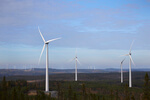New ESMAP Report Highlights Key Factors for Successful Development of Offshore Wind in Emerging Markets
Offshore wind is a rapidly growing industry which holds tremendous promise for many emerging markets as a large-scale, clean, reliable form of new electricity generation with the potential to stimulate valuable economic benefits, reduce emissions and increase energy access. Modelling of global decarbonization scenarios suggests that up to 2,000 gigawatts (GW) of capacity will need to be generated to reach net-zero emissions by 2050.
Emerging markets hold an unrealized potential of over 16,000 GW of technically extractable offshore wind resources. However, according to the report, entitled “Key Factors for Successful Development of Offshore Wind in Emerging Markets”, developing a new offshore wind sector in an emerging market is not an easy task. Decision makers must strike a careful balance as they consider a myriad of technical, political, environmental, and social challenges.
“Offshore wind is a promising option for large-scale decarbonization of energy systems in developing countries that must be optimized in order to meet the goals of the Paris Agreement,” said Demetrios Papathanasiou, Global Director for the World Bank’s Energy and Extractives Global Practice. “Development of offshore wind will also increase energy access and foster the creation of a dynamic industry that drives creation of long-term, skilled jobs. The World Bank stands ready to work with governments to create an enabling environment for the successful development of offshore wind markets in developing countries."
Through actions such as developing stable offshore wind policies and targets, creating an attractive environment for international financing, and providing bankable power offtake for projects, governments can create a successful and thriving offshore wind sector. Experience from established markets has shown that the success of deploying offshore wind can be maximized by:
- Recognizing that offshore wind, due to its large scale and high complexity, is significantly different from other forms of renewable energy, and needs strong, proactive government support to achieve the huge benefits it can bring.
- Clearly communicating the role of offshore wind as part of a long-term strategy and provide certainty through policy commitments to target volumes and dates.
- Proactively coordinating agencies to establish robust frameworks with clear processes to deliver bankable outcomes that meet good international industry practice.
- Collaborating with industry and stakeholders, to gather feedback on learning and experience, and use this to improve policy, frameworks, and delivery.
The report is a publication of the World Bank Group’s Offshore Wind Development Program led by ESMAP in partnership with the International Finance Corporation (IFC). It was prepared by Arup and BVG Associates. The Program was established in 2019 with the aim of accelerating the uptake of offshore wind in emerging markets by supporting the inclusion of offshore wind into the energy sector policies and strategies of World Bank Group client countries and the preparatory work needed to build a pipeline of bankable projects.
The Energy Sector Management Assistance Program (ESMAP)
The Energy Sector Management Assistance Program (ESMAP) is a partnership between the World Bank and 22 partners to help low- and middle-income countries reduce poverty and boost growth through sustainable energy solutions. ESMAP’s analytical and advisory services
are fully integrated within the World Bank’s country financing and policy dialogue in the energy sector. Through the World Bank Group (WBG), ESMAP works to accelerate the energy transition required to achieve Sustainable Development Goal 7 (SDG7) to ensure access to affordable, reliable, sustainable, and modern energy for all. It helps to shape WBG strategies and programs to achieve the WBG Climate Change Action Plan targets.
- Download the report at: https://bit.ly/3F3Wz3Z
- Watch the report’s promotional video at: https://www.youtube.com/watch?v=zkkii-tVZpo
- Source:
- ESMAP
- Author:
- Press Office
- Link:
- www.esmap.org/...
- Keywords:
- ESMAP, offshore, wind, development, emerging market, market, scale, volume, decarbonization, World Bank, report


























